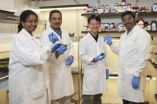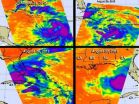(Press-News.org) With the help of beneficial bacteria, plants can slam the door when disease pathogens come knocking, University of Delaware researchers have discovered.
A scientific team under the leadership of Harsh Bais, assistant professor of plant and soil sciences in UD's College of Agriculture and Natural Resources, found that when pathogens attempt to invade a plant through the tiny open pores in its leaves, a surprising ally comes to the rescue. Soil bacteria at the plant's roots signal the leaf pores to close, thwarting infection.
The fascinating defense response is documented in video and micrographs of live plants taken by confocal and scanning electron microscopes at UD's Bio-Imaging Center at the Delaware Biotechnology Institute.
The research, which explored the interaction between the soil bacterium Bacillus subtilis and the laboratory plant Arabidopsis thaliana, is published in the August issue of The Plant Journal. The findings underscore both the importance of root-based processes in plant defense and the potential for bolstering plant immunity naturally through the emerging field of probiotics.
Postdoctoral researcher Amutha Sampath Kumar is the lead author of the journal article. In addition to Bais, the co-authors include postdoctoral researcher Venkatachalam Lakshmanan, researchers Jeffrey L. Caplan, Deborah Powell and Kirk J. Czymmek of UD's Bio-Imaging Center, and Delphis F. Levia, associate professor of geography. The National Science Foundation, University of Delaware Research Foundation and Delaware Experimental Program to Stimulate Competitive Research (EPSCoR) provided funding for the study.
Millions of stomata, consisting of microscopic pores surrounded by guard cells, cover the above-ground parts of plants, from the stems to the flower petals. The pores resemble tiny mouths, or doors, which the guard cells open and close to allow carbon dioxide, oxygen, water and minerals in and out of the plant.
Pathogens also can slip through these stomata and begin infecting the plant. However, as Bais's team confirmed, this invasion is halted when the beneficial bacterium Bacillus subtilis is present in the soil where the plant is rooted. The finding was based on tests of approximately 3,000 Arabidopsis plants inoculated with the foliar pathogen Pseudomonas syringae pathovar tomato DC3000 (PstDC3000) during a year-long period.
When a foliar pathogen attacks, as shown in previous research by Bais and his group, the plant recruits Bacillus subtilis to help and facilitates its multiplication. The Bacillus subtilis bacteria bind to the plant's roots and invoke abscisic acid and salicylic acid signaling pathways to close the stomata.
Abscisic acid and salicylic acid are both important hormones involved in plant defense. When a plant encounters adverse environmental conditions, such as drought, for example, abscisic acid triggers the stomata to shut tightly to prevent the plant from dehydrating.
In addition to ramping up plant disease resistance, the use of this rhizobacteria to promote drought tolerance in plants could be a very promising avenue, Bais notes.
"Many bacterial pathogens invade plants primarily through stomata on the leaf surface," Bais says. "But how do plants fight off infection? In our studies of the whole plant, we see this active enlistment by Bacillus subtilis, from root to shoot."
Strikingly, the research team's data revealed that of different root-associated soil bacteria tested, only Bacillus species were effective in closing the stomata and for a prolonged period.
"We know only 1 to 5 percent of what this bug Bacillus subtilis can do, but the potential is exciting," Bais notes, pointing out that there is increasing commercial interest in inoculating crop seeds with beneficial bacteria to reduce pathogen infection. "Just as you can boost your immune system, plants also could be supercharged for immunity."
INFORMATION:
Behind closed doors: Researchers show how probiotics boost plant immunity
2012-08-28
ELSE PRESS RELEASES FROM THIS DATE:
The effects of discrimination could last a lifetime
2012-08-28
Given the well-documented relationship between low birth weight and the increased risk of health problems throughout one's lifespan, it is vital to reduce any potential contributors to low birth weight. A new study by Valerie Earnshaw and her colleagues from Yale University sheds light on one possible causal factor. Their findings, published online in Springer's journal, the Annals of Behavioral Medicine, suggest that chronic, everyday instances of discrimination against pregnant, urban women of color may play a significant role in contributing to low birth weight babies.
Twice ...
Study explores injury risk in military Humvee crashes
2012-08-28
A new report by researchers from the Johns Hopkins Center for Injury Research and Policy examines the risk factors for injuries to U.S. military personnel from crashes involving highly mobile multipurpose wheeled vehicles (HMMWVs), more commonly known as Humvees. According to the study, involvement in combat and serving as the vehicle's operator or gunner posed the greatest risk for injury. It is the first published analysis of factors associated with Humvee injury risk in a deployed setting, and is in the August issue of the journal Military Medicine.
According to the ...
Johns Hopkins team finds ICU misdiagnoses may account for as many annual deaths as breast cancer
2012-08-28
Each year as many as 40,500 critically ill U.S. hospital patients die with an unknown medical condition that may have caused or contributed to their death, Johns Hopkins patient safety experts report in a recent study.
In a discussion of their findings, described online in BMJ Quality & Safety, researchers say that although diagnostic errors in the intensive care unit (ICU) may claim as many lives each year as breast cancer, they remain an underappreciated cause of preventable patient harm.
"Our study shows that misdiagnosis is alarmingly common in the acute care ...
The Quarterly Review of Biology: Why some fats are worse than others
2012-08-28
All dietary fats are not created equal. Some types of fats have been linked to ailments like heart disease and diabetes, while others, like those often found in plants and fish, have well documented health benefits.
So why do our bodies respond so destructively to some fats but not others?
A new hypothesis described in latest issue of The Quarterly Review of Biology suggests the answer may lie in how different fats interact with the microbes in our guts. According to researchers from the University of New Mexico and Northwestern University, some fats may encourage ...
Darwin discovered to be right: Eastern Pacific barrier is virtually impassable by coral species
2012-08-28
A coral species that is found in abundance from Indonesia eastward to Fiji, Samoa, and the Line Islands rarely crosses the Eastern Pacific Barrier toward the coast of the Americas, according to a team of researchers led by Iliana Baums, an assistant professor of biology at Penn State University. Darwin hypothesized in 1880 that most species could not disperse across the marine barrier, and Baums's study is the first comprehensive test of that hypothesis using coral. The results of the scientific paper, which will be published in the journal Molecular Ecology, has important ...
NASA infrared time series of Tropical Storm Isaac shows consolidation
2012-08-28
NASA's Atmospheric Infrared Sounder or AIRS instrument is an infrared "eye" that flies onboard NASA's Aqua satellite. AIRS has been providing the National Hurricane Center with valuable temperature data on Isaac's clouds and the surrounding sea surface temperatures, and a time series of data shows that Isaac is consolidating.
The AIRS instrument has been monitoring Tropical Storm Isaac for several days. AIRS data from Aug. 24, 25, 26 and 27 showed Isaac's movements through the eastern and central Caribbean Sea, across eastern Cuba and into the Gulf of Mexico. On Aug. ...
Rising cardiovascular incidence after Japanese earthquake 2011
2012-08-28
Munich, Germany – August 27 2012: The Japanese earthquake and tsunami of 11 March 2011, which hit the north-east coast of Japan with a magnitude of 9.0 on the Richter scale, was one of the largest ocean-trench earthquakes ever recorded in Japan. The tsunami caused huge damage, including 15,861 dead and 3018 missing persons, and, as of 6 June 2012, 388,783 destroyed homes.
Following an investigation of the ambulance records made by doctors in the Miyagi prefecture, close to the epicentre of the earthquake and where the damage was greatest, cardiologist Dr Hiroaki Shimokawa ...
Panda preferences influence trees used for scent marking
2012-08-28
As solitary animals, giant pandas have developed a number of ways to communicate those times when they are ready to come into close contact. One means of this communication occurs through scent marking. A recent study by San Diego Zoo Global researchers, collaborating with researchers at the Institute of Zoology, Chinese Academy of Science, indicates that pandas make clear and specific choices about what trees are used for scent marking.
"Variables affecting the selection of scent-marking sites included bark roughnesss, presence of moss on the tree trunk, tree diameter ...
Arctic sea ice shrinks to new low in satellite era
2012-08-28
The extent of the sea ice covering the Arctic Ocean has shrunk. According to scientists from NASA and the NASA-supported National Snow and Ice Data Center (NSIDC) in Boulder, Colo., the amount is the smallest size ever observed in the three decades since consistent satellite observations of the polar cap began.
The extent of Arctic sea ice on Aug. 26, as measured by the Special Sensor Microwave/Imager on the U.S. Defense Meteorological Satellite Program spacecraft and analyzed by NASA and NSIDC scientists, was 1.58 million square miles (4.10 million square kilometers), ...
WSU researcher documents links between nutrients, genes and cancer spread
2012-08-28
PULLMAN, Wash.—More than 40 plant-based compounds can turn on genes that slow the spread of cancer, according to a first-of-its-kind study by a Washington State University researcher.
Gary Meadows, WSU professor and associate dean for graduate education and scholarship in the College of Pharmacy, says he is encouraged by his findings because the spread of cancer is most often what makes the disease fatal. Moreover, says Meadows, diet, nutrients and plant-based chemicals appear to be opening many avenues of attack.
"We're always looking for a magic bullet," he says. "Well, ...



